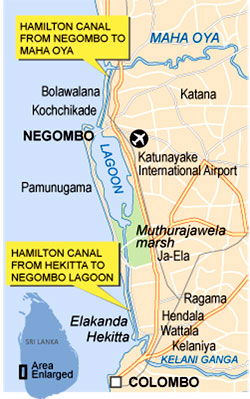The Hamilton Canal (also known as the Dutch Canal) is a canal (a waterway) connecting Puttalam to Colombo, passing through Negombo. The canal was constructed by the British in 1802 and completed in 1804. It was designed to drain salt water out of the Muthurajawela wetlands. The canal was named after Gavin Hamilton, the Government Agent of Revenue and Commerce.
The history of the canal network goes back to the reign of King Veera Parakramabahu VIII (1477-1496) who ruled the Kingdom of Kotte. It is said that the King constructed the canal connecting outlying villages with Colombo and the Negombo Lagoon, to ease the transport of spices, and most important of all, cinnamon, to the Kingdom’s main ports.
The Portuguese constructed the original canal in the 17th century, but it was the traders from the Dutch East India Company who expanded the canal, in the next century. The Dutch settlers also used the canal to transport pearls and spices from the north to Colombo.
The Dutch were displaced by the British. Between 1802 and 1804, when the island was under British rule, a new Colombo-Negombo canal was built and commissioned. It was named the Hamilton Canal in 1804, after the well-known English Agent of Revenue and Commerce Garvin Hamilton, who was based in Colombo.
Archive pictures confirm that distinctive padda-boats were the prime method of transportation. R L Brohier in Seeing Ceylon (1965) describes them as
large flat-bottomed boats or barges, square at both ends and with a steer both at bow and stern, so that the vessel’s passage through the water may be facilitated. Padda-boats are generally poled like a punt and are fitted at the stern with an outside oar serving as a rudder. They are often fitted with a removable cadjan roof sloping toward either side.
Hamilton Canal run west of the Old Dutch Canal, quite close to the sea, from the mouth of the Kelani Ganga at Hekitta to the southern edge of the Negombo Lagoon at Pamunugama, a distance of 21.5 kilometres.

Elakanda is where the Hamilton Canal begins and runs west of the Old Dutch Canal towards the Negombo Lagoon. About six kilometres up, the Hamilton Canal reaches the Muthurajawela marsh, a paradise of tall grasses and pollarded trees, with white flowers, birds, fish and butterflies, and also the occasional crocodiles and pythons.
From Pamunugama, the Hamilton Canal reaches the Negombo lagoon.
At the north end of the lagoon, right in the middle of town, the Hamilton Canal continues north. At its entrance in Negombo, it is much smaller, shallower and congested with small fishing boats with just enough room for the boats to pass each other. After about five kilometres it empties into the Maha Oya, which is a fresh water lagoon adjoining the Indian Ocean.
Canals are usually dull, but this one is really a river, at any rate at its northern part, and most attractive, fringed with lotus under palms and mangroves, alive with parakeets. It’s a charming tree-shaded waterway: coconut palms always lean to see their reflections, and here the film star Gloriosa Superba (Niyangala Mal) was climbing the trunks in the same justified vanity.
Roland Raven-Hart in Ceylon: History in Stone (1964)
There are a cluster of small concrete bridges (which have been repaired) over the canal through which the inhabitants pass, and where ferries once prevailed.
Although the Hamilton Canal was developed reinforcing both sides with stonework and chip-tile laden broad pavements, its water is now highly polluted.
Locals claim that they used to bathe in the canal years ago. Today, not even a boy wades through the canal due to the pollution caused by all the sewage lines from nearby houses, which point directly into the canal.
Sri Lankans had a very bad habit to dump their garbage everywhere; it seemed to us that they had a special preference for any kind of water spots. So, the Hamilton Canal was highly polluted with plastics and many other unimaginable things. On the one hand, it was great to see that Sri Lanka had maintained the canal for so much of years and still makes use of it; but on the other hand, it was unacceptable seeing all that trash thrown out in the water. We would have liked to understand why they polluted their own environment like that. Was it a lack of environmental education or was it the government that was not providing a proper disposal?
Niry Fidelis (Me with my Suitcase)
In 2012 the Sri Lanka Land Reclamation and Development Corporation commenced work rehabilitating and restoring the canal. The first stage was a 9 kilometre stretch between Maha Oya and Negombo. The second phase of the work between the Kelani Ganga and Negombo commenced on 20 February 2013. The first 2.5 kilometre section, between the Hekiththa junction and Pinwatta was completed on 2 August 2013.
Wide service roads, landscaped footpaths and scenic walkways now stretch parallel to the canals while tranquil water reflects glorious colours of the surroundings.

The bridge above the Hamilton`s Canal in Wattala
The potential for tourism is enormous, as the Canal has been developed to make it a scenic attraction for tourists. It is the perfect venue for the tourist who wants a little adventure and at the same time experience the beauty and history of the colonial settlers’ ancient spice trade.
Credit – Wikipedia, Sunday Observer, Explore Sri Lanka, 94 • LIFESTYLE, Me with my Suitcase

















Loading…
Loading…